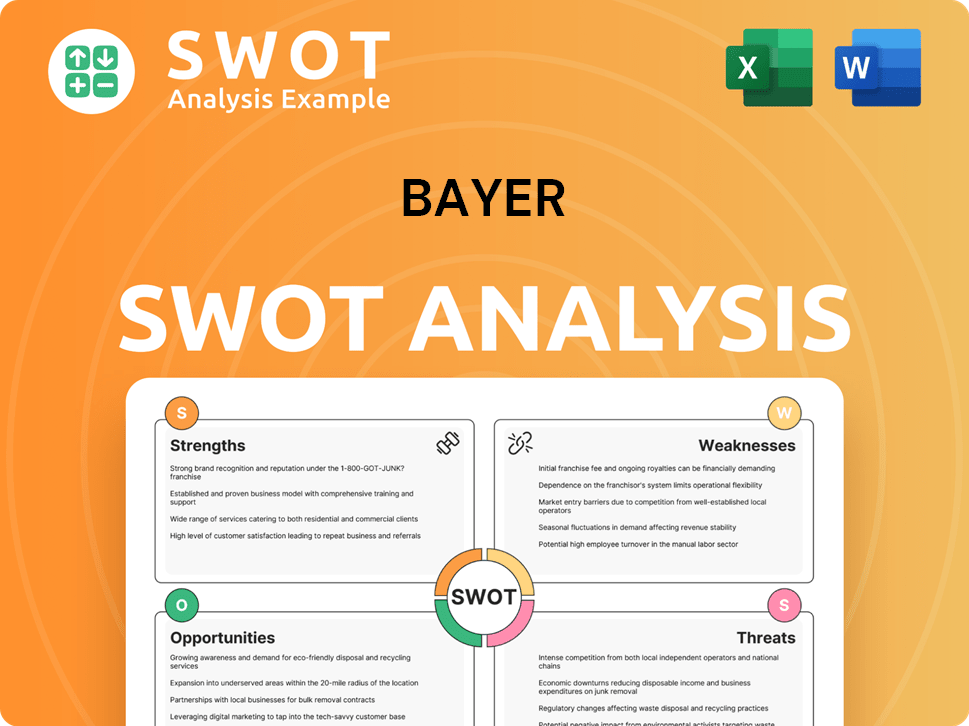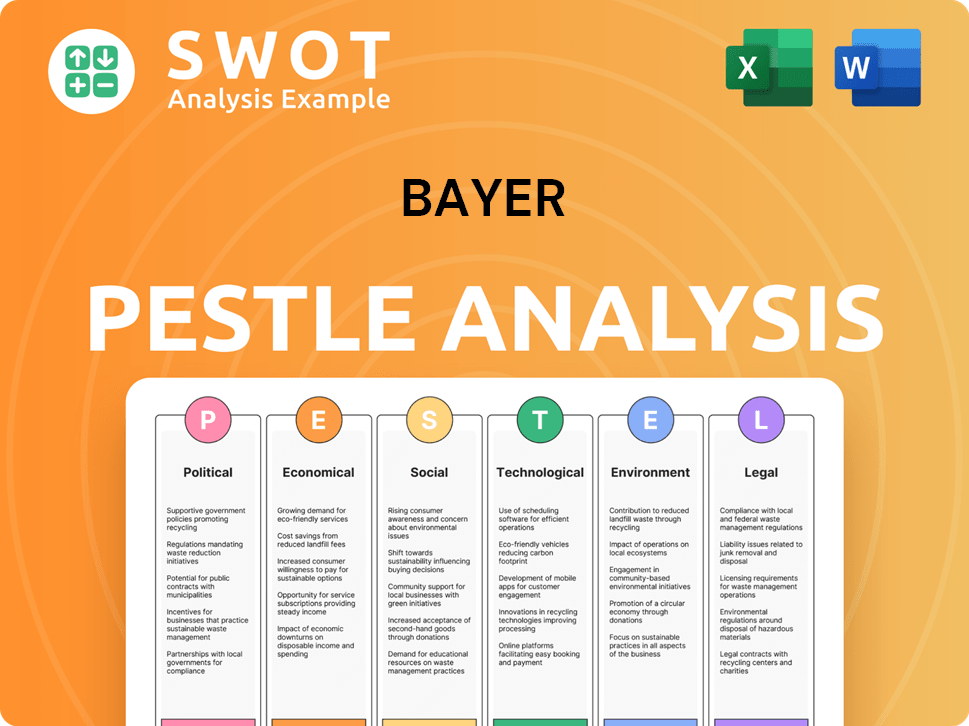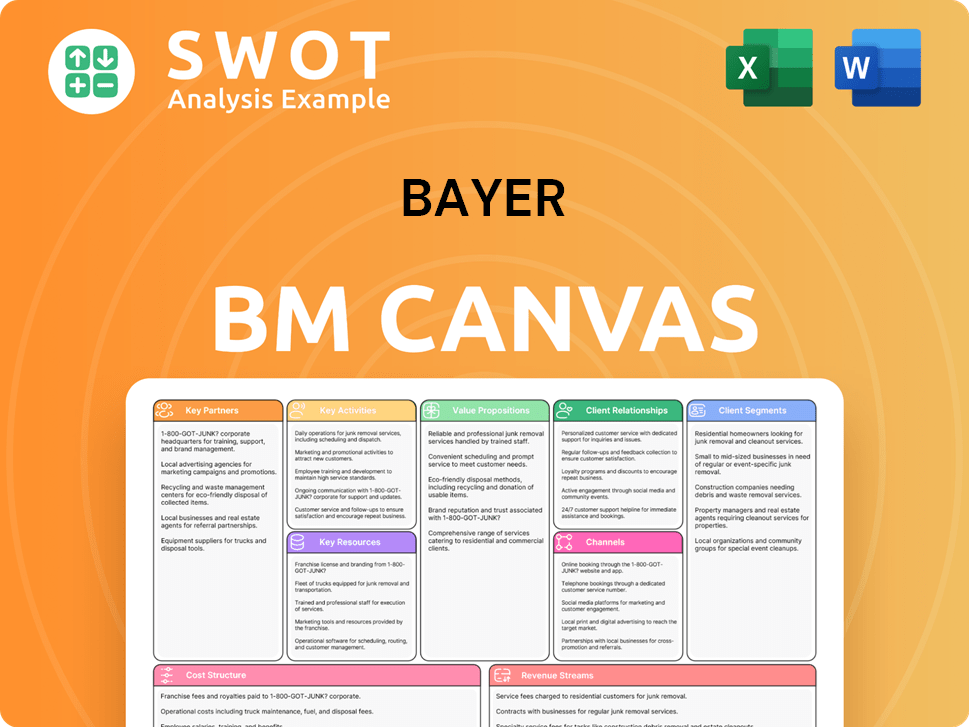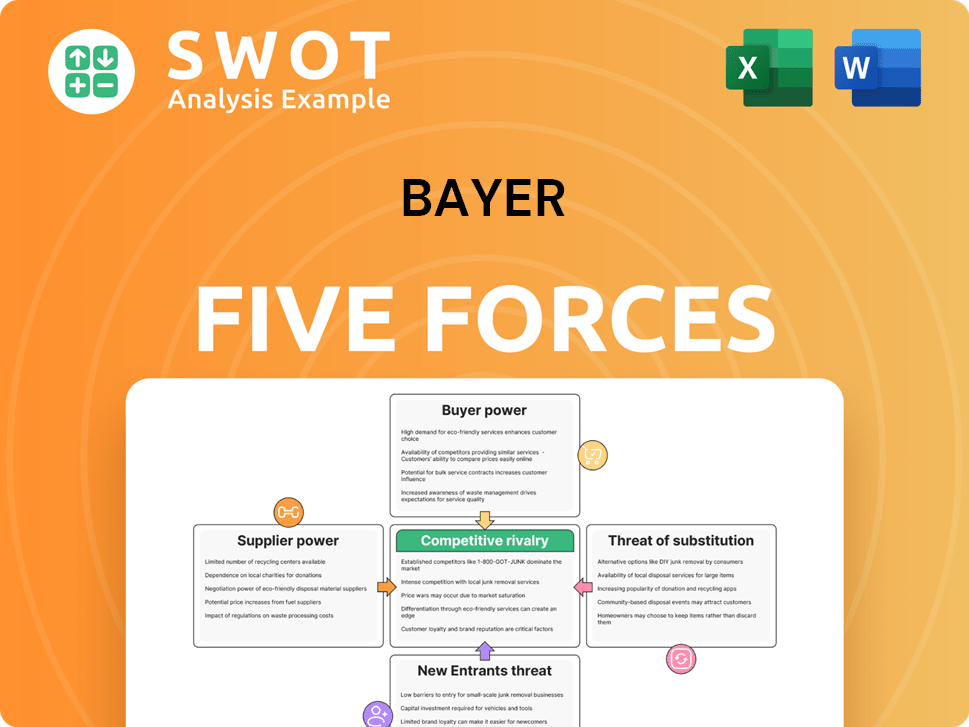Bayer Bundle
How Does Bayer Navigate Its Competitive Battlefield?
Bayer, a titan in life sciences, is a global force in pharmaceuticals, consumer health, and crop science. Its history, dating back to 1863, is a testament to its commitment to scientific breakthroughs and its impact on human, animal, and plant health. From its origins as a dye manufacturer, Bayer has evolved into a multinational powerhouse, constantly adapting to meet evolving market demands.

To truly grasp Bayer's position, we must dissect its Bayer SWOT Analysis and the fierce competition it faces. This deep dive into the Bayer competitive landscape will explore its strategic positioning within the Bayer industry, identifying its primary competitors and analyzing how Bayer leverages its core advantages. Understanding Bayer's business strategy and its market analysis is crucial for investors and strategists alike, providing insights into the challenges and opportunities that shape its future in the global market. We'll examine Bayer's market share compared to competitors and evaluate its financial performance versus rivals.
Where Does Bayer’ Stand in the Current Market?
Bayer's competitive landscape is shaped by its diverse operations in pharmaceuticals, consumer health, and crop science. The company's market position is influenced by its ability to innovate, manage its portfolio, and navigate industry-specific challenges. A thorough Bayer market analysis reveals the complexities of its competitive environment.
The company's value proposition centers on providing innovative healthcare solutions and sustainable agricultural practices. Bayer's strategic focus includes investing in research and development to maintain a competitive edge and address evolving market needs. Understanding the Bayer industry dynamics is crucial for assessing its overall performance.
Bayer's core operations are divided into three main divisions: Pharmaceuticals, Consumer Health, and Crop Science. Each division faces unique challenges and opportunities within its respective markets. The Bayer business strategy involves adapting to changing market conditions and focusing on long-term growth.
The Pharmaceuticals Division is expected to see a sales decline of approximately 4% to 5% in 2024, after currency and portfolio adjustments. This is primarily due to the loss of exclusivity for key drugs such as Xarelto and Eylea. However, growth drivers like Nubeqa and Kerendia are projected to generate around €5 billion in sales by 2029.
The Consumer Health Division is forecast to achieve modest sales growth of 3% to 4% in 2024. This growth is driven by strong brands like Claritin and Aspirin. The division's performance reflects the stability and resilience of its key product lines.
The Crop Science Division is expected to experience a significant sales decline of about 1% to 4% in 2024, on a currency- and portfolio-adjusted basis. This decline is primarily attributed to lower glyphosate prices. The division faces ongoing challenges related to market dynamics.
In 2023, Bayer's sales were distributed as follows: Europe/Middle East/Africa at €13.784 billion, North America at €17.514 billion, and Asia/Pacific at €10.370 billion. This geographical diversity underscores Bayer's global presence and market reach.
Bayer's strategic initiatives include portfolio management and significant investments in research and development. These efforts are crucial for maintaining a competitive edge and driving future growth. Understanding Bayer's competitive landscape requires an examination of these initiatives.
- Divestment of Environmental Science Professional business in 2022 for $2.6 billion.
- R&D expenses reached €6.2 billion in 2023, representing 12.6% of sales.
- Focus on innovation in areas like precision agriculture and personalized medicine.
- Ongoing efforts to address challenges from patent expirations and commodity price fluctuations.
Bayer SWOT Analysis
- Complete SWOT Breakdown
- Fully Customizable
- Editable in Excel & Word
- Professional Formatting
- Investor-Ready Format

Who Are the Main Competitors Challenging Bayer?
Understanding the Bayer competitive landscape is crucial for any market analysis. The company operates in three main sectors: Pharmaceuticals, Consumer Health, and Crop Science, each facing distinct sets of rivals. This dynamic environment requires continuous assessment of Bayer competitors and their strategies.
Bayer's business strategy is significantly influenced by the competitive pressures within each of these sectors. The company's success hinges on its ability to innovate, maintain market share, and navigate the challenges posed by its rivals. This analysis provides a detailed look at the key players and the competitive dynamics at play.
In the Pharmaceuticals sector, Bayer competes with major global players. These companies are focused on drug discovery, development, and market access. The competition is particularly intense in high-value therapeutic areas.
Key competitors in the Pharmaceuticals sector include Pfizer, Novartis, Roche, Merck & Co., and Johnson & Johnson. These companies invest heavily in research and development (R&D) to bring new drugs to market. The competition also involves securing patent protection.
The Consumer Health segment faces competition from well-known brands. These companies compete through brand recognition, marketing, and distribution networks. Advertising campaigns and shelf space are key battlegrounds.
Major competitors in Consumer Health include Johnson & Johnson, Procter & Gamble, GlaxoSmithKline, and Sanofi. These companies offer a wide range of over-the-counter medications and personal care products. The market is driven by consumer preferences and brand loyalty.
In the Crop Science division, Bayer competes in the agricultural inputs market. This involves the development and sale of seeds, crop protection products, and digital farming solutions. The acquisition of Monsanto significantly altered this landscape.
Bayer's primary competitors in Crop Science are BASF, Syngenta (ChemChina), and Corteva Agriscience. These companies are investing in biotechnological advancements and sustainable agricultural practices. Precision agriculture and data-driven solutions are becoming increasingly important.
The competitive landscape for Bayer is shaped by innovation, market access, and strategic partnerships. Recent acquisitions and investments in R&D are crucial for maintaining a competitive edge. For example, in 2023, Bayer invested approximately €5.8 billion in R&D across its divisions. Understanding the Bayer market analysis requires a deep dive into these factors.
- Pharmaceuticals: The focus is on new drug approvals and patent protection. Bayer's Nubeqa competes with drugs from Johnson & Johnson and Astellas in the oncology market.
- Consumer Health: Competition is driven by brand recognition and marketing. Companies vie for shelf space in pharmacies and retail outlets.
- Crop Science: The acquisition of Monsanto strengthened Bayer's position. Rivals invest in biotechnological advancements and sustainable practices. The agricultural input industry is undergoing consolidation.
- Bayer's position in the global market is influenced by its ability to innovate and adapt to changing market conditions.
- For a deeper understanding of Bayer's history, consider reading the Brief History of Bayer.
Bayer PESTLE Analysis
- Covers All 6 PESTLE Categories
- No Research Needed – Save Hours of Work
- Built by Experts, Trusted by Consultants
- Instant Download, Ready to Use
- 100% Editable, Fully Customizable

What Gives Bayer a Competitive Edge Over Its Rivals?
Understanding the Bayer competitive landscape requires a deep dive into its strengths, weaknesses, and strategic positioning within the pharmaceutical, consumer health, and crop science sectors. The company faces a dynamic environment shaped by innovation, regulatory changes, and intense competition. This analysis explores the key factors that define Bayer's competitive advantages and its position relative to its main rivals.
Bayer's strategic moves and competitive edge are significantly influenced by its substantial investments in research and development (R&D). The company's diversified product portfolio and strong brand recognition also play crucial roles. Examining these elements provides insights into Bayer's ability to navigate market challenges and capitalize on growth opportunities. For a deeper understanding of the company's ownership structure, you can explore the information provided by Owners & Shareholders of Bayer.
The Bayer market analysis reveals a company that is constantly evolving to meet the demands of its various markets. Its ability to integrate advanced technologies and develop sustainable solutions further solidifies its competitive standing. This adaptability is crucial for maintaining a strong position in the Bayer industry.
Bayer's significant investment in R&D is a key differentiator. In 2023, Bayer allocated €6.2 billion to R&D, which represented 12.6% of its sales. This commitment drives the development of proprietary technologies and intellectual property, particularly in pharmaceuticals and crop science. This investment is crucial for sustaining its competitive edge.
The company's diversified portfolio across pharmaceuticals, consumer health, and crop science provides a strategic advantage. This diversification mitigates risks associated with single-market fluctuations. Cross-divisional synergies also enhance operational efficiency and market responsiveness, helping the company to compete effectively.
Bayer's strong brand recognition is a significant competitive advantage. Brands like Aspirin and Claritin in consumer health, and its historical presence in crop science, command significant trust and recognition. This brand loyalty, built over decades, supports market share and customer retention.
Bayer benefits from extensive global operations, which facilitate economies of scale in manufacturing, procurement, and distribution. Its wide-reaching distribution networks ensure the accessibility of its products in diverse markets. This global footprint is essential for capturing market opportunities.
Bayer's competitive advantages are multifaceted, stemming from its robust R&D, diversified portfolio, and strong brand recognition. These strengths are crucial in the pharmaceutical industry competition and the broader market. These factors help Bayer maintain its position in the global market.
- R&D Investment: High investment in R&D, with €6.2 billion in 2023, fuels innovation.
- Diversified Portfolio: Broad product range across pharmaceuticals, consumer health, and crop science.
- Brand Recognition: Strong brands like Aspirin and Claritin build customer trust.
- Global Presence: Extensive distribution networks ensure product accessibility.
Bayer Business Model Canvas
- Complete 9-Block Business Model Canvas
- Effortlessly Communicate Your Business Strategy
- Investor-Ready BMC Format
- 100% Editable and Customizable
- Clear and Structured Layout

What Industry Trends Are Reshaping Bayer’s Competitive Landscape?
The life sciences sector, where Bayer operates, is experiencing significant shifts driven by technological advancements, regulatory changes, and evolving market dynamics. This environment presents both hurdles and opportunities for Bayer. Understanding the Bayer competitive landscape requires a close examination of these trends to assess its strategic positioning and future prospects. The Bayer industry faces intense competition, necessitating continuous adaptation and innovation.
Bayer's position is influenced by its diverse portfolio across pharmaceuticals, consumer health, and crop science. Risks include regulatory pressures, pricing challenges, and the need for substantial R&D investments. The future outlook depends on Bayer's ability to innovate, manage its portfolio effectively, and navigate global economic and political uncertainties. A deeper dive into the Bayer market analysis reveals the complexities of its competitive environment.
Technological advancements are transforming drug discovery, personalized medicine, and precision agriculture. Digital farming solutions and gene-editing technologies offer opportunities for Bayer to enhance its crop science offerings. AI-driven drug development can accelerate the identification of new compounds and optimize clinical trials.
Pharmaceutical pricing scrutiny and environmental regulations for agricultural chemicals pose challenges. Governments globally are increasing scrutiny on drug costs, impacting profitability. Environmental concerns and stricter pesticide regulations demand innovation in sustainable agricultural practices.
Geopolitical tensions and supply chain disruptions present ongoing challenges for global operations. The need for continuous R&D investment to maintain a competitive edge in both pharmaceuticals and crop science is crucial. Adapting to evolving consumer preferences and healthcare trends is also essential.
Emerging markets, particularly in Asia and Latin America, offer substantial growth potential. The rising prevalence of chronic diseases drives demand for innovative pharmaceutical products. Increased food production with sustainable methods presents a vast market for Bayer's crop science division. Strategic partnerships and acquisitions can open new avenues for growth.
Bayer needs to focus on innovation, especially in areas like gene editing and digital health, to stay ahead of the curve. Strategic partnerships and acquisitions are key to expanding its market reach and product offerings. Addressing regulatory challenges and environmental concerns is crucial for long-term sustainability.
- Enhance R&D efforts in pharmaceuticals to address unmet medical needs and gain a competitive edge.
- Invest in digital farming solutions to improve agricultural productivity and sustainability.
- Strengthen partnerships with biotech companies and research institutions to accelerate innovation.
- Adapt to changing market dynamics by focusing on personalized medicine and precision agriculture.
The Bayer's main rivals in pharmaceuticals include major players like Roche, Novartis, and Johnson & Johnson. In crop science, key competitors include Corteva Agriscience and BASF. Understanding the competitive landscape is vital for formulating effective business strategies. For deeper insights into the market, consider reading this article about the Target Market of Bayer.
Bayer Porter's Five Forces Analysis
- Covers All 5 Competitive Forces in Detail
- Structured for Consultants, Students, and Founders
- 100% Editable in Microsoft Word & Excel
- Instant Digital Download – Use Immediately
- Compatible with Mac & PC – Fully Unlocked

Related Blogs
- What are Mission Vision & Core Values of Bayer Company?
- What is Growth Strategy and Future Prospects of Bayer Company?
- How Does Bayer Company Work?
- What is Sales and Marketing Strategy of Bayer Company?
- What is Brief History of Bayer Company?
- Who Owns Bayer Company?
- What is Customer Demographics and Target Market of Bayer Company?
Disclaimer
All information, articles, and product details provided on this website are for general informational and educational purposes only. We do not claim any ownership over, nor do we intend to infringe upon, any trademarks, copyrights, logos, brand names, or other intellectual property mentioned or depicted on this site. Such intellectual property remains the property of its respective owners, and any references here are made solely for identification or informational purposes, without implying any affiliation, endorsement, or partnership.
We make no representations or warranties, express or implied, regarding the accuracy, completeness, or suitability of any content or products presented. Nothing on this website should be construed as legal, tax, investment, financial, medical, or other professional advice. In addition, no part of this site—including articles or product references—constitutes a solicitation, recommendation, endorsement, advertisement, or offer to buy or sell any securities, franchises, or other financial instruments, particularly in jurisdictions where such activity would be unlawful.
All content is of a general nature and may not address the specific circumstances of any individual or entity. It is not a substitute for professional advice or services. Any actions you take based on the information provided here are strictly at your own risk. You accept full responsibility for any decisions or outcomes arising from your use of this website and agree to release us from any liability in connection with your use of, or reliance upon, the content or products found herein.